Can bearded dragons eat raspberries? It’s a common question among reptile owners who want to offer their scaly friends a more varied and nutritious diet. With their sweet flavor and antioxidant-rich profile, raspberries seem like a healthy treat — but are they truly safe for bearded dragons?
If you’ve ever found yourself wondering, “Can bearded dragons eat raspberries regularly, or should they be given only occasionally?” — you’re not alone. While bearded dragons can enjoy a wide range of fruits and vegetables, not all options are created equal. Some may offer nutritional benefits, while others could disrupt their digestive health if not fed properly.
In this article, we’ll explore everything you need to know about raspberries and bearded dragons — including safety, preparation tips, how often to serve them, and what experts say about their place in a reptile’s balanced diet.
Can Bearded Dragons Eat Raspberries? A Nutritional Overview
Raspberries are sweet, juicy, and packed with nutrients—but does that mean they’re safe for your bearded dragon? Before offering this fruit as a treat, it’s important to understand how its nutritional content aligns with your reptile’s unique dietary needs. Let’s break down what raspberries really offer and how they stack up against other common fruits.
Can Bearded Dragons Eat Raspberries? Nutritional Pros and Cons
Raspberries are packed with essential nutrients like vitamin C, vitamin K, manganese, and small amounts of fiber. These elements can support immune health and digestion in small, occasional servings. They also contain antioxidants, which may help reduce cellular stress. However, raspberries are high in natural sugars, which can be problematic for bearded dragons when consumed frequently.
Too much sugar in a beardie’s diet can lead to obesity, digestive upset, or even long-term organ stress. The fruit’s fiber content, while beneficial in moderation, may cause bloating or diarrhea if overfed. Hydration is a positive side benefit, as raspberries are made up of nearly 85% water. This can help reptiles stay hydrated, especially during warmer months or after shedding. Despite these positives, raspberries are not a balanced source of nutrition on their own. They should never replace staple greens or protein-rich insects in your bearded dragon’s diet.
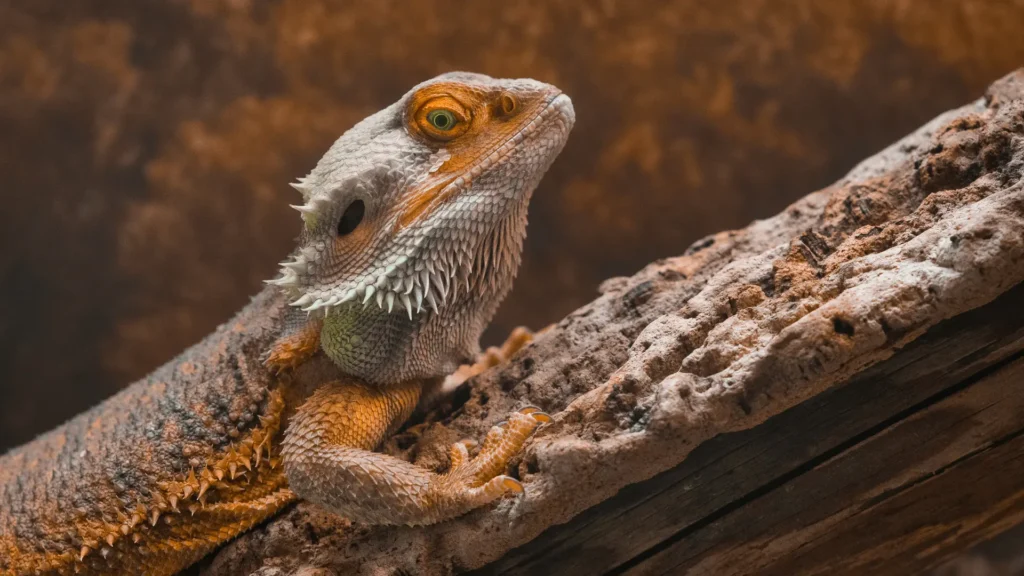
How Raspberries Interact with a Bearded Dragon’s Digestive System
Bearded dragons have a relatively simple digestive system that is not designed to handle large quantities of fruit. Raspberries contain natural sugars and a moderate level of acidity, which can irritate the digestive tract if offered too frequently. These sugars may also ferment in the gut, leading to gas, bloating, or soft stools.
In addition, the fiber in raspberries can be both helpful and harmful. Small amounts can assist with regular bowel movements, but too much may result in diarrhea or dehydration. The acidity of the fruit may be too harsh for some beardies, especially babies or those with sensitive digestion. While a small raspberry now and then is unlikely to cause harm, consistent overfeeding can lead to chronic issues. For optimal digestive health, raspberries should be served sparingly, alongside fiber-rich greens and easily digestible proteins.
Can Bearded Dragons Eat Raspberries Without Calcium Loss?
When feeding bearded dragons any fruit or vegetable, two important nutritional markers must be considered: oxalates and the calcium-to-phosphorus ratio. Raspberries are relatively high in oxalates—natural compounds that can bind to calcium and prevent its absorption. This poses a risk because calcium is critical for bone development and preventing metabolic bone disease (MBD).
Additionally, raspberries contain more phosphorus than calcium. Bearded dragons require a calcium-to-phosphorus ratio of around 2:1 in their diet. Raspberries offer the opposite, making them a poor source of balanced nutrition. Over time, a diet high in phosphorus and low in calcium can cause skeletal issues and other serious health problems. For this reason, raspberries should be fed only in small amounts and never as a staple food. Always pair occasional fruit treats with calcium-rich staples to maintain a healthy dietary balance.
Raspberries vs. Other Fruits: Which Are Healthier?
While raspberries are safe in moderation, there are better fruit choices for bearded dragons. Fruits like papaya, mango, and blueberries offer similar sweet flavors but tend to have better calcium-to-phosphorus ratios or lower oxalate levels. Blueberries, for example, are also high in antioxidants but are less acidic than raspberries, making them gentler on the digestive system.
Mangoes are rich in vitamin A, an essential nutrient for vision and skin health. Papaya supports digestion and hydration and is lower in oxalates. Apples, when peeled and cored, can be a mild option with low acidity and moderate fiber content. While all fruits should still be offered in moderation, rotating between lower-risk options can reduce the chances of dietary imbalances. Compared to these alternatives, raspberries fall short in terms of mineral safety. They are better treated as an occasional treat rather than a regular part of your bearded dragon’s fruit intake.
Can Baby Bearded Dragons Eat Raspberries?
Raspberries may seem like a harmless treat, but not all fruits are equally safe for bearded dragons. While they offer some nutritional value, feeding raspberries comes with important limitations and potential risks. In this section, we’ll explore when raspberries are safe to feed—and when they might do more harm than good.
Are Raspberries Safe for Baby Bearded Dragons?
Baby bearded dragons have more sensitive digestive systems and specific nutritional needs for rapid growth. While raspberries aren’t toxic, they are not ideal for hatchlings or very young beardies. The high sugar content and acidity can upset a young dragon’s stomach or lead to diarrhea.
Additionally, young dragons require a higher protein intake to support proper development. Their diet should mainly consist of insects like crickets or dubia roaches, along with calcium-rich greens. Offering sugary fruits too early can lead to picky eating habits and unbalanced nutrition.
If you do choose to offer raspberries to a baby beardie, do so extremely sparingly—no more than a tiny piece once every few weeks. Always monitor for any changes in behavior or stool afterward. Most reptile experts recommend avoiding fruit entirely for dragons under 6 months old. It’s best to wait until your pet is older and more nutritionally stable before experimenting with sugary treats.
Potential Health Risks of Too Much Fruit
While fruits like raspberries offer hydration and nutrients, overfeeding them can create serious health issues. The most immediate concern is excess sugar. Bearded dragons are not biologically equipped to handle high amounts of sugar, which can lead to obesity, liver stress, or even insulin resistance over time.
Another risk is gastrointestinal distress. Raspberries contain fiber and acidity, which in excess can irritate the digestive tract, causing diarrhea or bloating. Over time, a diet heavy in fruit can also cause nutritional imbalances, especially if it replaces essential staples like leafy greens and insects.
The oxalates in raspberries pose a more long-term threat by interfering with calcium absorption. This can increase the risk of metabolic bone disease (MBD), particularly if your dragon’s overall diet is already low in calcium. Feeding fruit too often also encourages picky eating habits, making your pet refuse healthier options.
To avoid these risks, limit fruit to no more than 10% of your bearded dragon’s diet and prioritize variety, balance, and moderation in every feeding.
Signs of a Negative Reaction to Watch For
After feeding your bearded dragon raspberries, it’s important to watch for any signs of a negative reaction. Common short-term symptoms include loose or runny stool, which may indicate that the fruit was too sugary or acidic for your pet’s digestive system. Some dragons may also experience temporary lethargy or bloating after eating fruit.
If your bearded dragon becomes less active, loses appetite, or stops passing regular stool, these could be early signs of digestive distress. In more severe cases, long-term overfeeding of sugary foods like raspberries may lead to weight gain or visible swelling around the abdomen.
Discoloration of the beard or stress marks can also appear when a dragon isn’t feeling well. Keep an eye on stool consistency, energy levels, and behavior over the next 24 to 48 hours. If symptoms persist, remove the fruit from their diet and consult a reptile veterinarian. Monitoring these signs helps ensure that raspberries remain an occasional treat—not a source of health problems.
Preparing Raspberries for Bearded Dragons: Step-by-Step Guide
Feeding raspberries to your bearded dragon requires more than just dropping a berry into their bowl. Proper preparation helps minimize health risks and ensures your pet gets the most benefit from this occasional treat. In this section, you’ll learn how to safely select, clean, and serve raspberries the right way.
Should You Use Fresh, Organic, or Frozen Raspberries?
When choosing raspberries for your bearded dragon, fresh and organic is the safest and most recommended option. Organic fruits are grown without synthetic pesticides or chemical fertilizers, reducing your pet’s exposure to harmful residues. Since bearded dragons are highly sensitive to toxins, even small amounts can be harmful over time.
If organic raspberries aren’t available, non-organic ones can be used if washed thoroughly. Rinse them under cool running water and gently rub the surface to remove dirt, bacteria, and as much chemical residue as possible. Frozen raspberries are another option, but they must be unsweetened and additive-free. Always check the label for added sugars or preservatives, which can harm reptiles.
Before serving, thaw frozen raspberries completely and allow them to reach room temperature. Feeding fruit straight from the freezer can shock your dragon’s digestive system. Avoid canned or processed raspberries entirely, as they usually contain syrup, citric acid, or other harmful additives. For best results, use fresh, organic raspberries in small, clean servings.
Proper Washing and Cutting Methods
Washing raspberries properly is essential for removing harmful bacteria, pesticides, and debris. Even if labeled as organic, raspberries should always be rinsed thoroughly before being served to your bearded dragon. Use cool, running water and gently rub the fruit with your fingers to dislodge any dirt or potential contaminants.
Avoid soaking the fruit for too long, as raspberries are delicate and can easily become mushy. If your dragon is small, consider cutting the raspberry into halves or quarters to make it easier to eat and prevent choking. Smaller pieces also help with portion control and reduce the chances of overeating. Use a clean knife and cutting board reserved for reptile food to avoid cross-contamination with human foods or raw meat.
Raspberries should be served immediately after preparation to maintain freshness and nutritional value. Never offer moldy, overly soft, or bruised fruit, as these can cause digestive issues or bacterial infections. Simple, careful preparation makes raspberries a safer and more enjoyable snack for your bearded dragon.
What About Raspberry Seeds and Leaves?
While the flesh of a raspberry is generally safe in small amounts, the seeds and leaves can raise safety concerns. Raspberry seeds are edible for humans, but they may be too fibrous and hard for a bearded dragon’s digestive system. If you’re offering only one or two raspberries, the seeds likely won’t cause problems—but it’s best to mash or finely chop the fruit to reduce any risk of impaction.
Raspberry leaves, on the other hand, are not typically recommended for bearded dragons. Although they are sometimes used in herbal teas, raspberry leaves may contain tannins and other compounds that can affect calcium absorption or cause digestive irritation in reptiles. There’s also little research on their long-term safety in reptiles.
As a general rule, stick to the fruit only and avoid feeding any part of the plant that hasn’t been specifically studied or approved for reptile consumption. When in doubt, offer safe, well-researched vegetables or greens instead. Always remove stems, leaves, and any seeds when preparing fruit for your pet.
Creative Feeding Ideas for Picky Bearded Dragons
Some bearded dragons can be picky eaters, especially when it comes to fruit. If yours turns their nose up at raspberries, try presenting the fruit in a more engaging way. One method is to mix a small piece of raspberry with other approved foods like collard greens, squash, or bell peppers. This creates a colorful and flavorful salad that may pique your beardie’s curiosity.
You can also try hand-feeding raspberries using feeding tongs. Moving the fruit slightly can stimulate your dragon’s hunting instinct, encouraging them to take a bite. Another fun option is to hide the raspberry in their enclosure under a leaf or near their basking area—turning snack time into a mini enrichment activity.
Avoid offering raspberries on their own too often, as this might encourage your dragon to expect sugary treats and ignore their staple diet. Always pair creative feeding methods with nutritious staples, and rotate fruits regularly to maintain variety and avoid boredom. Picky dragons can learn to accept healthy foods when feeding feels fun and interactive.
Healthier Alternatives to Raspberries for Bearded Dragons
While raspberries can be offered as an occasional treat, they aren’t the most nutrient-dense option for your bearded dragon. Many other fruits—and especially leafy greens—provide better balance with lower sugar, fewer oxalates, and higher calcium. In this section, we’ll explore healthier alternatives that support your dragon’s long-term health.
Top Fruits That Are Low in Sugar and Oxalates
Some fruits are safer and more nutritionally balanced for bearded dragons than others. If you’re looking for healthier alternatives to raspberries, focus on options that are lower in sugar and oxalates. These fruits reduce the risk of calcium-binding issues and digestive upset, while still providing a sweet, occasional treat.
Papaya is one of the top choices. It’s rich in vitamin A and fiber, yet low in oxalates. Figs—especially fresh ones—offer calcium and antioxidants with moderate sugar levels. Prickly pear (cactus fruit) is another excellent option. It contains hydration-boosting water content and beneficial nutrients while being gentler on a bearded dragon’s system.
Other safe choices include mango and blueberries, though they are slightly higher in sugar and should be fed in smaller portions. Always serve fruits fresh and pesticide-free, and cut them into small, manageable pieces. Offering these safer fruits occasionally can satisfy your dragon’s sweet cravings without compromising their overall health. Just remember: even the best fruits should never make up more than 10% of your pet’s total diet.
Some fruits like papaya or prickly pear are safer than raspberries, but vegetables like bell peppers also make great occasional treats. If you’re curious, here’s a complete guide on whether bearded dragons can eat bell peppers and how to serve them properly.
Daily vs. Occasional Fruits: What’s the Difference?
Understanding the difference between daily and occasional fruits is essential for maintaining your bearded dragon’s long-term health. Daily fruits are those with low sugar, low oxalates, and a balanced calcium-to-phosphorus ratio. However, very few fruits qualify for regular feeding. Most are best offered in small amounts, once or twice per week.
Occasional fruits include those that are higher in sugar, acidity, or oxalate content. Raspberries, strawberries, and kiwi fall into this category. These fruits should only be used as treats and should never replace essential foods like leafy greens or insects.
Examples of fruits that are better suited for more frequent use include papaya and prickly pear, both of which are easier on digestion and provide helpful vitamins. Even then, moderation is key. Keep portions small and infrequent, and always monitor how your beardie responds.
Overuse of fruit—even healthy ones—can lead to digestive issues, obesity, or metabolic imbalance. By distinguishing between daily and occasional fruit types, you can keep your pet’s diet varied, interesting, and well-balanced.
Combining Fruit with Leafy Greens for a Balanced Diet
A great way to make fruit safer and more nutritious for bearded dragons is to pair it with leafy greens. This helps create a balanced meal that still includes the occasional sweetness your pet might enjoy. Fruits can also enhance the aroma and color of salads, making meals more appealing to picky eaters.
Start with a base of calcium-rich, low-oxalate greens like collard greens, mustard greens, or dandelion leaves. Then, add a small amount of chopped fruit—no more than one or two teaspoons, depending on the size of your dragon. This ratio keeps sugar intake low while improving flavor and texture variety.
Avoid mixing in fruits with every meal. Instead, use fruit combinations a couple of times per week as a treat or enrichment tool. You can even rotate fruit types to expose your bearded dragon to new flavors.
This balanced approach supports digestion, nutrient absorption, and long-term health. It also encourages natural foraging behavior, especially if fruit is hidden among the greens in small portions.
Herpetologist-Approved Treats for Long-Term Wellness
Reptile veterinarians and herpetologists often recommend specific fruits and treats that align with a bearded dragon’s biological needs. While raspberries are acceptable on rare occasions, experts typically suggest safer options like papaya, prickly pear, figs, and blueberries when offering fruit. These fruits provide beneficial nutrients with fewer dietary drawbacks.
In addition to fruit, other treats that support long-term wellness include edible flowers such as hibiscus or nasturtiums, as well as the occasional waxworm or silkworm. These items can be rotated in small amounts to offer variety without overwhelming the dragon’s digestive system.
Treats should always complement, not replace, the core diet of leafy greens, vegetables, and live insects. Experts recommend sticking to a 90/10 rule—90% staple foods, 10% treats including fruit.
When in doubt, consult a reptile-savvy veterinarian or herpetologist. They can help you build a diet plan tailored to your bearded dragon’s age, size, and health status. Following expert-approved guidelines ensures your dragon enjoys its snacks without sacrificing overall wellness.
Optimizing Your Bearded Dragon’s Diet: Expert Insights
Feeding your bearded dragon the right foods goes far beyond the occasional fruit treat. To truly support their health and longevity, you need to understand the balance between insects, greens, and supplements. In this section, we’ll explore expert-backed strategies for creating a well-rounded, sustainable diet.
The Importance of Variety, Rotation, and Moderation
Variety is essential in a bearded dragon’s diet, both for nutritional balance and mental stimulation. Feeding the same foods repeatedly can lead to nutrient deficiencies and boredom, which may cause picky eating or loss of appetite. By rotating different greens, vegetables, fruits, and insects, you provide a broader range of vitamins, minerals, and textures.
Moderation is equally important, especially when it comes to fruits and high-fat insects like waxworms. Even healthy foods can cause issues if overfed. For example, too much spinach can interfere with calcium absorption, while frequent sugary fruits can upset digestion. Aim to offer staple foods daily, such as collard greens, dubia roaches, and squash, while rotating occasional treats weekly.
Keep a feeding schedule that allows your bearded dragon to experience a mix of familiar and new foods. This not only improves overall health but also mimics the variety they’d find in the wild. A balanced, rotating menu keeps your beardie engaged at mealtime and helps prevent long-term health problems caused by diet repetition or overfeeding.
Balancing Fruits, Veggies, and Insects
Creating a balanced diet for your bearded dragon depends heavily on their age and energy needs. Younger dragons require more protein, meaning their diet should consist of about 70% insects and 30% vegetables and greens. As they mature, this ratio reverses—adults should have roughly 70% vegetables and 30% insects.
Fruits should make up no more than 10% of the overall diet, regardless of age. They are best used as occasional treats due to their sugar content. Insects like crickets and dubia roaches provide protein and stimulate natural hunting behaviors, while greens like mustard, collard, and dandelion offer essential vitamins and calcium.
Vegetables such as bell peppers, squash, and carrots add variety and support digestion. Offering all these components in the right proportions ensures that your dragon gets the nutrients they need without overloading on sugar or fat. Always observe your dragon’s behavior and adjust portions as needed based on their growth, energy levels, and appetite. Following trusted bearded dragon feeding recommendations can help you choose the right foods and portion sizes at each life stage.
Monitoring Calcium Intake and Avoiding Metabolic Bone Disease
Calcium is one of the most vital nutrients in a bearded dragon’s diet. Without proper intake and absorption, dragons can develop metabolic bone disease (MBD), a painful and often irreversible condition that affects their bones and mobility. To prevent this, it’s important to monitor both calcium-rich foods and supplementation habits.
Choose greens with a favorable calcium-to-phosphorus ratio, such as collard greens and turnip greens. These help support bone strength and overall health. Avoid high-oxalate foods like spinach and beet greens, as they can block calcium absorption.
Dust feeder insects with a calcium supplement several times per week, especially if your dragon is young or actively growing. Also, ensure your pet receives regular UVB lighting, which helps convert calcium into a usable form within their body. Without UVB exposure, even a calcium-rich diet may not be effective. Regular monitoring and a thoughtful feeding plan are key to avoiding long-term health issues.
When to Consult a Reptile Vet for Dietary Advice
While it’s possible to manage a healthy diet at home, certain signs may indicate the need for professional help. If your bearded dragon shows symptoms like weight loss, lethargy, refusal to eat, swollen limbs, or soft jaw bones, these may be related to nutritional deficiencies or imbalances.
A reptile-savvy veterinarian can perform blood tests, physical exams, and fecal analysis to identify any underlying issues. They can also review your feeding schedule and recommend adjustments based on your pet’s age, weight, and activity level. This guidance is especially helpful for new owners or for dragons recovering from illness.
Consulting a vet can also provide clarity on proper supplementation, safe treat options, and UVB lighting requirements. Don’t wait for symptoms to worsen. When in doubt, a quick visit or virtual consultation can make a big difference in your dragon’s long-term health and comfort.
FAQ
Can bearded dragons eat raspberries every day?
No, bearded dragons should not eat raspberries daily. The high sugar and oxalate content make them suitable only as an occasional treat.
How often can I give my bearded dragon raspberries?
You can offer raspberries once every one to two weeks. Always serve in small portions alongside a balanced diet of greens and insects.
Are raspberry seeds safe for bearded dragons?
Raspberry seeds are not toxic, but they can be hard to digest. It’s best to mash or finely chop the fruit to avoid digestive issues.
Can baby bearded dragons eat raspberries?
It’s not recommended. Baby beardies have sensitive digestive systems and higher protein needs, so fruit should be avoided until they’re older.
Do bearded dragons like raspberries?
Some do enjoy the taste and texture. However, not all dragons will eat fruit, and it should never replace their staple diet.
What fruits are safer than raspberries for bearded dragons?
Papaya, prickly pear, figs, and mango are generally safer in small amounts. They contain fewer oxalates and better calcium-to-phosphorus ratios.
What happens if a bearded dragon eats too much fruit?
Overfeeding fruit can lead to diarrhea, bloating, weight gain, and long-term calcium deficiency. Moderation is key.
Should I use frozen raspberries for my bearded dragon?
You can, but make sure they’re unsweetened and fully thawed. Fresh, organic raspberries are still the safer choice.
Conclusion: Can Bearded Dragons Eat Raspberries Safely?
Yes, bearded dragons can eat raspberries, but only as an occasional treat—not a regular part of their diet. While raspberries offer hydration and small amounts of antioxidants, vitamin C, and fiber, their high sugar and oxalate content pose nutritional risks if fed too often. Over time, excessive fruit intake can contribute to digestive issues, calcium deficiency, and metabolic bone disease.
To safely include raspberries in your beardie’s feeding routine, serve tiny, well-washed pieces no more than once every 1–2 weeks, and always pair them with calcium-rich greens and protein from gut-loaded insects.
Think of raspberries as a bonus, not a staple—something to brighten up a varied, balanced diet. When in doubt, consult a reptile-experienced veterinarian to ensure your dragon’s nutrition supports their health, growth, and longevity.

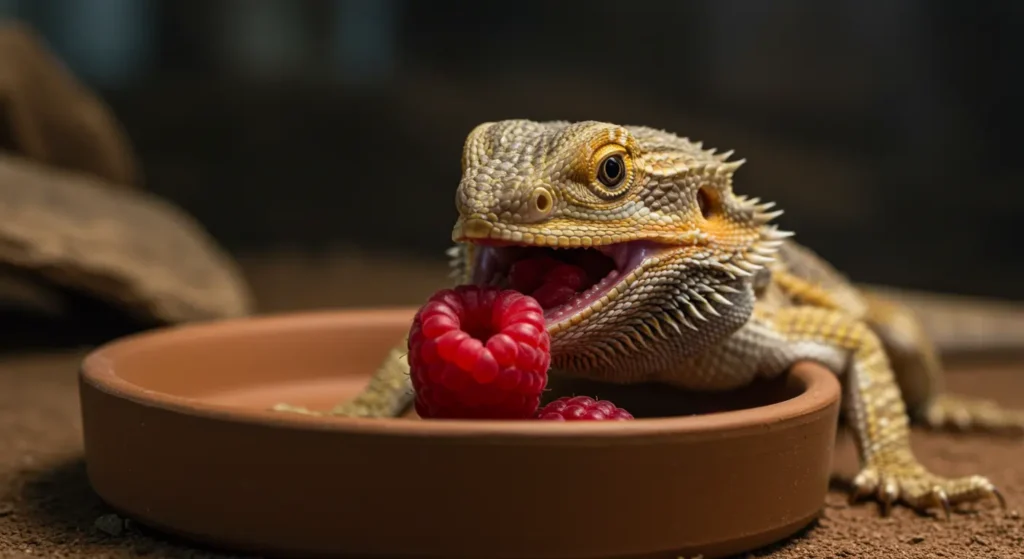
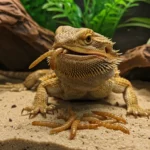

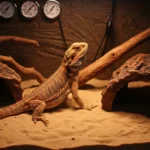

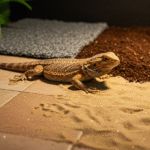
1 thought on “Can Bearded Dragons Eat Raspberries? The Sweet Truth”